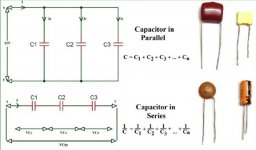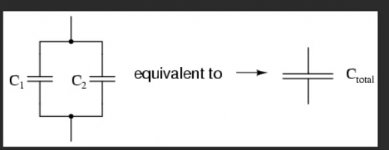Hi All.
I will be replacing 2 electrolytic capacitors in a pair of Dali Loudspeakers I have.
There are currently 2 x 22μF caps which I'll be replacing with polypropylene.
The closest my supplier has is 20μF.
If I replace the old caps with 20μF and 2μF caps do I fit these in series and will this deliver the same value?
In series meaning "circuit to 20μF cap, then this to 2μF cap, then to the other end of the circuit?
While at it the existing crossovers have 2 x 10w Bennic 5R6J resistors in each crossover.
Do these deteriorate and is it worth fitting fresh Dayton 10w Audio Grade resistors which I currently have?
Both are of the square profile ceramic casing type.
cheers
Cliff
I will be replacing 2 electrolytic capacitors in a pair of Dali Loudspeakers I have.
There are currently 2 x 22μF caps which I'll be replacing with polypropylene.
The closest my supplier has is 20μF.
If I replace the old caps with 20μF and 2μF caps do I fit these in series and will this deliver the same value?
In series meaning "circuit to 20μF cap, then this to 2μF cap, then to the other end of the circuit?
While at it the existing crossovers have 2 x 10w Bennic 5R6J resistors in each crossover.
Do these deteriorate and is it worth fitting fresh Dayton 10w Audio Grade resistors which I currently have?
Both are of the square profile ceramic casing type.
cheers
Cliff
Last edited:
Thanks M.
So just twist the wires of each capacitor to the other and solder the two ends into the circuit?
C
So just twist the wires of each capacitor to the other and solder the two ends into the circuit?
C
22uf is easy.
Cross-Cap 22uF
Personally I don't like Dayton stuff.
I find Jantzen far better.
10W Metal Oxide Resistors
Cross-Cap 22uF
Personally I don't like Dayton stuff.
I find Jantzen far better.
10W Metal Oxide Resistors
Thanks for the tip.
Good prices.
Aren't the Cross-Caps bottom of the range?
Also, do the MOX resistors include Ferris in their construction?
I understand Ferris metals become magnetised with a current and are slow to discharge leading to possible smearing of sound reproduction.
Also do resistors deteriorate with time?
Cheers
Cliff
Good prices.
Aren't the Cross-Caps bottom of the range?
Also, do the MOX resistors include Ferris in their construction?
I understand Ferris metals become magnetised with a current and are slow to discharge leading to possible smearing of sound reproduction.
Also do resistors deteriorate with time?
Cheers
Cliff
No, as Mooly suggests standard wirewound crossover resistors last and they remain stable in value over time. Also they are high tolerance, are good for low values of resistance, and are quite stable in value with temperature changes.Also do resistors deteriorate with time?
Thanks Allen.
I should have read the post more carefully.
I now understand that resistors are pretty stable, but has there been an improvement in performance since the 10w Bennic 5R6J resistors?
I'm thinking, the resistance value is only one factor of a number of possible variances I might experience from resistors which could affect sound reproduction.
For example, some advise to steer clear of ferris material in the circuit path between the Amp and the Drivers.
Would I experience a sonic benefit going to the Dayton examples or even the Jantzens?
Thanks
C
I should have read the post more carefully.
I now understand that resistors are pretty stable, but has there been an improvement in performance since the 10w Bennic 5R6J resistors?
I'm thinking, the resistance value is only one factor of a number of possible variances I might experience from resistors which could affect sound reproduction.
For example, some advise to steer clear of ferris material in the circuit path between the Amp and the Drivers.
Would I experience a sonic benefit going to the Dayton examples or even the Jantzens?
Thanks
C
Last edited:
Thanks for the tip.
Good prices.
Aren't the Cross-Caps bottom of the range?
Also, do the MOX resistors include Ferris in their construction?
Cliff
Did you bother to have a look through their website ?
You'll find all the info you need if you spend a little time doing research.
Hi Abuser.
Apologies if my post appeared impolite.
I did take your advice and visited their website soon after reading your post.
I also placed an order based on your recommendation.
But I never rely on merchants marketing alone.
The cross-caps were the cheapest in their line so my post was to learn more from you based on your experience.
Apologies if my post appeared impolite.
I did take your advice and visited their website soon after reading your post.
I also placed an order based on your recommendation.
But I never rely on merchants marketing alone.
The cross-caps were the cheapest in their line so my post was to learn more from you based on your experience.
In retrospect my post was rude, so I apologise.
I won't bother people with my personal problems 🙂
Yes the cross caps are their cheapest film cap.
I find them better than all of the 'budget' caps I've tried.
If you want a cap that will change your perspective on how caps sound, try the superiors.
As for the resistors, I can't say I've ever heard of anything like ferris issues.
Normally power resistors are ni-chrome wound on a fibreglass former.
My personal experience is Jantzen good.
Dayton not so much.
Having said that, I do Love their DATS system. Brilliant.
I won't bother people with my personal problems 🙂
Yes the cross caps are their cheapest film cap.
I find them better than all of the 'budget' caps I've tried.
If you want a cap that will change your perspective on how caps sound, try the superiors.
As for the resistors, I can't say I've ever heard of anything like ferris issues.
Normally power resistors are ni-chrome wound on a fibreglass former.
My personal experience is Jantzen good.
Dayton not so much.
Having said that, I do Love their DATS system. Brilliant.
If you ask whether MOX resistors contain ferrous materials, then you are asking if they have iron in their composition.Also, do the MOX resistors include Ferris in their construction?
The resistance material for metal oxide (MOX) resistors is tin oxide - no iron.
The resistance material for wire-wound resistors is either nickel-chromium alloy (Nichrome) or copper-nickel-manganese alloy (Manganin) - again, no iron.
The resistor elements won’t have iron in them, but that doesn’t mean the end caps or leads won’t. Some do. Ferrous metals will introduce distortion if you *induce* a high current in them. Stay coupling probably won’t induce enough current to matter. Conducted currents don’t have the same effect, although eddy currents are possible. If you want an iron free resistor, check it with a magnet - that’s the only way to be sure unless it is specified on a data sheet.
Cliff , ignore the abuser , Mooly didn’t send you to research by yourself , he answered your question in a nice pedagogical way , this is the point of this blog.
The resistor elements won’t have iron in them, but that doesn’t mean the end caps or leads won’t. Some do. Ferrous metals will introduce distortion if you *induce* a high current in them. Stay coupling probably won’t induce enough current to matter. Conducted currents don’t have the same effect, although eddy currents are possible. If you want an iron free resistor, check it with a magnet - that’s the only way to be sure unless it is specified on a data sheet.
Good advice.
I use a magnet to check other parts but never thought to use it on resistors.
I've just tested some Dayton resisters which I have on hand and they're not magnetic.
Are sandcast resisters the ones encased in what looks like a ceramic oblong shape and usually white?
A speaker blogger I came across refers to sandcast resistors as junk and used by manufacturers to keep costs down.
Is he making a fair or unfair judgement?
The resistor elements won’t have iron in them, but that doesn’t mean the end caps or leads won’t. Some do. Ferrous metals will introduce distortion if you *induce* a high current in them.
Do typical HiFi Amps deliver enough high current for Ferrous metals to introduce distortion?
Is it prudent to generally avoid ferrous in the signal path wherever this can be done cheaply?
He is simply giving an opinion.A speaker blogger I came across refers to sandcast resistors as junk and used by manufacturers to keep costs down.
Is he making a fair or unfair judgement?
You and I do not necessarily have to share his opinion. We should be capable of researching the issue and making our own judgements.
Cliff, why don't you simply Google for 'sandcast resistor images'?Are sandcast resisters the ones encased in what looks like a ceramic oblong shape and usually white?
sandcast resistor images - Google Search
Thanks G.
I'm mindful not to attach to opinions which align with beliefs.
Sifting through the opinions makes it difficult to identify the facts.
I'll just continue to explore opinions until I can prove or disprove them with my own tests. 🙂
One thing I've identified.
Quality components in crossovers has a big bearing.
I compared nine pairs of speakers which I hadn't touched.
The pair which by far had the best dynamic range, detail, and sound stage were the Dali's.
Then I opened up all the speakers to find that the Dali's were the only ones using quality gauge air core inductors, and polycaps.
All the others were using either very thin gauge inductors, iron core inductors, and electrolytic caps, and some with ferrous parts in the signal path.
Although this wasn't scientifically conclusive.
It may have been the Dali Drivers which made the difference, but the other speakers which I recapped and altered, all improved significantly.
Regarding ferrous, I'll just avoid it if this is economically achievable.
I'm mindful not to attach to opinions which align with beliefs.
Sifting through the opinions makes it difficult to identify the facts.
I'll just continue to explore opinions until I can prove or disprove them with my own tests. 🙂
One thing I've identified.
Quality components in crossovers has a big bearing.
I compared nine pairs of speakers which I hadn't touched.
The pair which by far had the best dynamic range, detail, and sound stage were the Dali's.
Then I opened up all the speakers to find that the Dali's were the only ones using quality gauge air core inductors, and polycaps.
All the others were using either very thin gauge inductors, iron core inductors, and electrolytic caps, and some with ferrous parts in the signal path.
Although this wasn't scientifically conclusive.
It may have been the Dali Drivers which made the difference, but the other speakers which I recapped and altered, all improved significantly.
Regarding ferrous, I'll just avoid it if this is economically achievable.
Last edited:
- Home
- Design & Build
- Parts
- Capacitor question?

